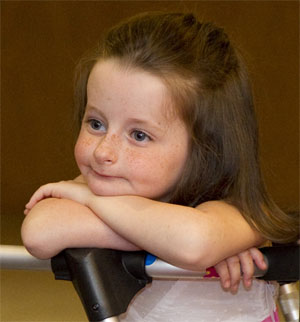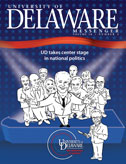Study seeks to strengthen fragile bones

RESEARCH | At age 8, Mallie is half a head shorter than her 5-year-old brother, Liam. She has already fractured more than 30 bones in her tiny body and undergone four surgeries so that she can walk.
Mallie has osteogenesis imperfecta (OI), commonly referred to as “brittle bone disease.” She is one of more than 25,000 Americans with this genetic disorder, which is characterized by fragile bones that break easily.
In search of a new treatment for this debilitating disease, a team of researchers from the University and Nemours/Alfred I. duPont Hospital for Children is initiating a two-year study exploring the use of a Food and Drug Administration-approved vibration platform in children with OI. The team includes Christopher Modlesky, associate professor in UD’s Department of Kinesiology and Applied Physiology, and Dr. Michael Bober, a pediatric geneticist at Nemours.
“This device has previously been shown to increase bone mineral density in post-menopausal woman,” Bober says. “Our new study will look at whether or not this non-invasive technique can lead to improvement in bone strength in the pediatric population.
“The DuPont Hospital is excited to once again partner with the University of Delaware’s Human Performance Lab for this research study. Christopher Modlesky and his ongoing studies with daily vibration treatment were instrumental in bringing the vibration platform to the hospital.”
In April more than 100 people came together at the hospital for an announcement that the project had received funding from the Osteogenesis Imperfecta Foundation (OIF). A second grant brings the hospital into the foundation’s Linked Clinical Research Centers network, which collects and analyzes health information from adults and children with OI.
During the announcement ceremony, Tracy Smith Hart, OIF chief executive officer, referred to Modlesky’s research as innovative. “We’re very excited about his idea,” she said, “and we thank all of you for this partnership.”
Two of Modlesky’s graduate students, Brianne Mulrooney and Deepti Bajaj, unveiled the vibration platform, which resembles an oversize bathroom scale. Children in the study, ranging in age from 5-10 years, will be placed on the device for 10 minutes daily over a nine-month period. Half will be on the experimental device, which emits high-frequency, low-magnitude vibrations. The other half of the study pool will be placed on a placebo plate.
“We want to see whether this technique can stimulate bone growth,” Modlesky says. “We also plan to monitor diet and activity level. If the approach is successful, we’re hoping it could be used as an alternative to drug therapy.”
Mulrooney, who earned her bachelor’s degree in biological sciences at UD in 2009, became interested in exercise science through an undergraduate research project with Modlesky. Now pursuing a master’s degree and working on the OI project, she plans ultimately to attend medical school and says she will gain valuable experience from being part of this joint academic-clinical research study.
“Studies like this that partner the University of Delaware with its biomedical and clinical partners—in this case, Nemours/A.I. duPont Children’s Hospital—are representative of the translational research fostered by the Delaware Health Sciences Alliance [DHSA],” says Kathleen Matt, dean of the College of Health Sciences and executive director of the DHSA. “The alliance looks to support and expand bench-to-bedside collaborations to develop new diagnostics, preventive therapies and interventions.”
Article by Diane Kukich, AS ’73, ’84M





